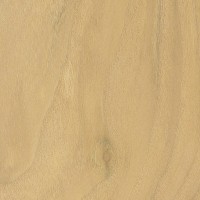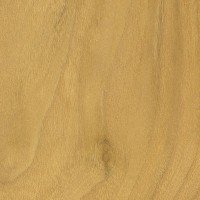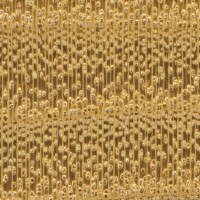 |
Common Name(s): Mulberry Scientific Name: Morus spp. (Morus alba, M. nigra, M. rubra, etc.) Distribution: Red Mulberry is native to Eastern North America, other species are found worldwide Tree Size: 30-50 ft (10-15 m) tall, 1-1.5 ft (.3-.5 m) trunk diameter Average Dried Weight: 43 lbs/ft3 (690 kg/m3) Specific Gravity (Basic, 12% MC): .55, .69 Janka Hardness: 1,680 lbf (7,470 N) Modulus of Rupture: 11,680 lbf/in2 (80.6 MPa) Elastic Modulus: 1,352,000 lbf/in2 (9.32 GPa) Crushing Strength: 6,990 lbf/in2 (48.2 MPa) Shrinkage: Radial: 3.3%, Tangential: 6.6%, Volumetric: 10.3%, T/R Ratio: 2.0 |
Color/Appearance: Heartwood is a golden brown, darkening to a medium/reddish brown with age. Sapwood is a pale yellowish white. Overall appearance is very similar to Osage Orange.
Grain/Texture: Grain is straight, with a uniform medium texture. Good natural luster.
Endgrain: Ring-porous; large earlywood pores 2-5 rows wide, small latewood pores in clusters and tangential bands; tyloses and other gum deposits common; parenchyma vasicentric, aliform, and confluent; medium to wide rays, spacing normal.
Rot Resistance: Rated as very durable, with good insect resistance and weathering properties.
Workability: Responds well to both hand and machine tools. Turns, glues, and finishes well.
Odor: No characteristic odor.
Allergies/Toxicity: Besides the standard health risks associated with any type of wood dust, no further health reactions have been associated with Mulberry. See the articles Wood Allergies and Toxicity and Wood Dust Safety for more information.
Pricing/Availability: Due to its small size and scattered distribution, Mulberry is seldom if ever harvested commercially for lumber. Smaller pieces are sometimes available locally throughout the tree’s natural range. Expect prices to be high for a domestic hardwood.
Sustainability: This wood species is not listed in the CITES Appendices or on the IUCN Red List of Threatened Species.
Common Uses: Fence posts, furniture, and turned objects.
Comments: Mulberry species are perhaps better known for their edible fruit. The leaves of White Mulberry (Morus alba) are also the primary food source for the silkworm (Bombyx mori), which is used to produce silk.
The wood itself looks very similar to Osage Orange, though Mulberry tends to be significantly lighter. Black Locust also bears a close resemblance to Mulberry, and it’s weight is only slightly higher than Mulberry’s. However, the two may be easily separated with a blacklight, as Mulberry is non-fluorescent, while Black Locust is highly fluorescent under a blacklight (see video below).
None available.
Scans/Pictures: A special thanks to Mike Leigher for providing the wood sample, and Steve Earis for providing the turned photo of this wood species.
 |
 |
 |
 |
 |
[iframe id=”https://www.youtube.com/embed/vCOxU64Ka2s?rel=0″]





I’m still sorry I wasn’t able to rescue the main trunk, but I got some 3′ sections which I split and which have been drying for a few years; I’m finally getting around to doing something with them, so I can add a pic or two of slices to the collection. The first includes some of the rough split surface which has darkened after a few years of storage. Sunlight speeds that up, but even in my basement that aging process takes place. It also shows the high contrast between heartwood and sapwood, and that the sapwood does not seem… Read more »
Just got this piece of what I was told is mulberry. One side is planed and sanded and the other is rough sawn. About 4.5 feet long.
I love to use mulberry for game calls, but seldom find it available. I have been able to salvage a few blocks locally when a tree is damaged. It turns and finishes well. The attached picture shows one of my calls using American holly to contrast with the yellow of the mulberry.
I’m currently taking out 2 trees that are in my way they were pollarded so there may be some nice projects material there. I live in northern Ca if you want any pieces. I would rather somebody put it to good use if you can
Another underappreciated tree, at least in North America. I believe in Asia this tree is prized for its wood as well as its bark which is used for fine paper. Silk is derived from worms which feed on the white mulberry. Failed attempts to introduce white mulberries into the mid Atlantic colonies means that you can find hybrids today whose fruit will be pale. The wood is very nice and has so many good properties not the least of which is rot resistance. In many ways its a fruit wood but has ring porous end grain making it look a… Read more »
Lightning took out this beautiful white Mulberry. The wood is almost all heartwood with only a thin layer of whitish sapwood. Golden to golden/brownish heartwood. Very pretty
Thanks to one of Nebraska’s famous wind storms, blew in at 81knots, my beloved 50 year old mulberry tree lost its top. I was planning to harvest the tree in the spring and mill the main trunk which was tall and straight to make a table top 8’x4’ for our new dinning room. Alas the city got to my fallen tree top before I did but my daughter convinced them to cut the trunk into 2 1/2’ logs for me and will be using them to make end tables instead as well as some bowl,boxes, candlesticks and anything else I… Read more »
I had a neighbor remove an 80+ year old fruitless mulberry and once the tree crew got paid, they left and never returned leaving three huge rounds from the base of the trunk. They neighbor said I would be welcome to have them. So I moved them across the street (I instantly understood why the tree guys left them once they got their check!) and three back breaking trips later had them in my back yard. Since I live in Northern California our stupidly insane hot dry 8 months of the year helped dry this quickly when exposed to sun… Read more »
Is there a good way to either increase or decrease the speed of darkening, similar to exposing cherry to more or less sunlight or fuming oak? I rescued a bunch of offcuts from a downed tree and am thinking of using them as furniture trim, but I’m wondering whether I might need/want to try to synchronize their aging to get consistent appearance.
It is an attractive wood. But as a “weed tree”, I’m not surprised it isn widely available commercially.
Exposed to sunlight, mulberry darkens rapidly and dramatically, however the sap wood will still be lighter and more gray.
Easy to make bows out of it, and boy, does it give fast bows!
In parts of Europe this wood (actually, the European species – black and white, that is) is used for barrels in which to store distilled spirits. It is preferred to oak, for that particular use.
Also, judging from personal experience and based on the description above, apparently the European varieties grow larger than the American one. I wonder if mechanical properties are also different. Visually, I’d say mulberry on both sides of the Atlantic looks the same, with the European varieties being maybe somewhat paler.
Is there any data for this wood to be used for outdoor decking?
There must have been samples of wood used to calculate these values. Were those samples all from one species (and if so, do you know which Morus species?) or were there samples used from different species such that the values here represent some kind of rough average of the different species? Or did whoever calculated the values for the samples simply not clearly record which Morus species he tested? And if that’s the case, is there good reason to assume that Morus rubra and Morus alba would yield very similar test results? Thanks!
This wood is gorgeous.
I’ve harvested a 20″ diameter red mulberry tree and worked with the wood. I believe the properties stated in the article are accurate and the information quoted by JocelyneS above is not accurate. The stuff is strong, fairly hard and fairly dense. Green logs are super heavy, but it loses a lot of weight as it dries. The raw wood is a rather garish yellow, but the heartwood quickly oxidizes to a nice mellow brown. The sapwood stays light cream colored. See photo of my favorite snack bowl, turned from this tree.
I just cut boards out of some quartered logs from my 20″ red mulberry tree. The wood is now down to 8.5% moisture. A 1.5 cu. in. sample of heartwood weighed 18.488 g. If my math is right, that translates to a density of nearly 47 lb/cu. ft., even at a lower moisture content than the 12% standard. The sapwood on these logs is so degraded from rot and borers that it is crumbling away in places, but the adjacent heartwood is completely untouched. Nice stuff! I’m hoping to find enough clear, quartersawn pieces to build a guitar, or at… Read more »
In Iran they make a guitar-type instrument from mulberry: https://en.wikipedia.org/wiki/Tar_(string_instrument)
I am currently building a uke from fruitless mulberry.. looks good so far!
I have just acquired my first one just two days ago. And you have hit it perfectly. Heavy. Incredibly dense. And almost yellow at the main trunk . I believe it’s a beautiful tree!
I am thinking about buying South American Mulberry flooring. Does Mulberry seasonally shrink a lot?
Encyclopedia of Life info on Red Mulberry doesn’t jive with your description. Link is below. They have a Comment by John Hilty of Illinois Wildflowers, and he says, “The wood of Red Mulberry is relatively light, soft, and weak; it is not important commercially. However, it has been used in the past to make fence posts, farm implements, furniture, interior finish, and caskets.”
https://eol.org/pages/594939/details
How does that not jive with what’s written here? It’s light, soft and weak but resistant to rot.
At 690 kg/m3 it’s heavier than English oak. How is that light? Its crushing strength and modulus of rupture are also not that far away from English oak, so I wouldn’t call it soft and weak either.
Is it possible to fume mulberry wood with ammonia? Does the wood have enough natural tannins for the ammonia to react with? And if so what colour change might one expect?
Its rather high in tannins and responds to lye much like cherry does. Don’t know about ammonia, but it turns blackish when in contact with rust like oak does.
I live in Paragould Arkansas and we have mulberry trees every where. A neighbor of mine had 1 cut and I am curious how to dry it for my pyrographics. And Should I cut it into slabs b4 i dry it?
This article might shed some light: https://www.wood-database.com/wood-articles/drying-wood-at-home/
Mine still has the bark, and I want to keep it that way I can’t do wax on bark cause it doesn’t want to come back off. Can’t I wrap it tight in a plastic on the side. Mine will have to air dry cause I don’t have a kiln.
Eventually the bark dries and falls off, at least some of it does, having a kind of fibrous inner layer that has been used to make paper in Asia. That’s been my experience. Diluted glue could probably soak in and hold it. Air drying is not a problem, better than most woods in my experience, but you need to coat the end grain well. For any log. Wax is not necessary and yellow wood glue followed by 2 or 3 coats exterior house paint (as glossy as possibly) actually works better. Asphalt emulsion such as is sold for driveways works… Read more »
I would stack them and place spacers between the rows. Now the rule of thumb is let air dry 1YEAR PER INCH OF THICKNESS of the boards. Hope this helps you.
I have a mulberry tree cut from the base to 73 inches long for a walking stick and have the bark peeled. How long should I let it dry before carving designs into it.
Cut June 11th so it was really easy to peel.
Your post is dated two years ago, so if you are still waiting you should be fine.
The stick is 2″ at one end and 1.5″ on the other end.
You could try the online forum, Wood Barter:
https://woodbarter.com/
This wood is mentioned in the bible as “wood that will not rot”.
good to know
thanks for the info